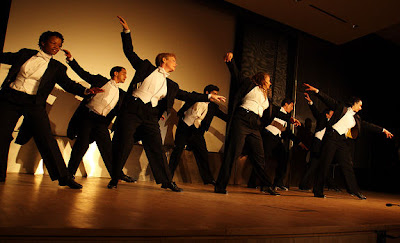Dance
Almost all of the islands of Indonesia have their own dance styles, but those best known are from Bali and Java. Dance and drama are practically inseparable, and performances are almost always accompanied by gamelan music.
Dancers take their art very seriously and practice for endless hours, usually from childhood, under the oversight of an expert. Unlike western style of dance, Indonesian dances are precise, jerky and at times, abrupt. They are also very expressive, with every fiber of the dancer involved, including the eye movements and finger twitches. Every dance tells a story, often a tale from the Hindu epic, Ramayana.
Bali is known for several prominent dances, and there are several other lesser known styles of dance as well, but all tell a story and to a greater or lesser degree, involve dramatic portrayal of a character in the story, sometimes while in a trance.
More than just an entertaining performance, the
Barong & Rangda dance is a colorful and lively drama. The barong, a
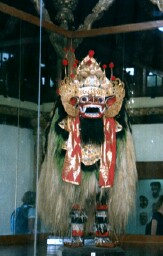
strange lion-shaggy dog creature that is operated much like the two-man circus horse, is the protector of a village and personifies good. Rangda is the evil widow witch. There are also barong supporters, men flailing dagger-like
krises. Although the barong is playful and jovial, once Rangda makes her attacking appearance, he becomes the protector and battles, along with the retaliating
kris-armed men. Rangda puts the men in a trance and they turn the daggers on themselves. The barong's magical powers see to it that the men are not harmed in the process. Amid the crashing din of the gamelan accompaniment, good and evil battle. The barong triumphs and Rangda finally retreats in defeat.
The Legong dance is considered to be the most graceful of the Balinese dances. There are several kinds of Legong dances, but the most commonly performed is the Legong Kraton (Palace Legong). In this dance there are three performers, two legongs and a condong, who is the attendant of the royal legongs. The condong introduces the dance and then exits the stage. Then enters the two legongs who are tightly clad in golden brocade and elaborately made up. They dance in exact formation to gamelan accompaniment. The performance ends when the condong enters with golden wings, as a bird of bad fortune, signifying that the king will die in battle.
For tourists, the best known Balinese dance is the Kecak.
This is an performance that tells a story of intrigue and romance from the
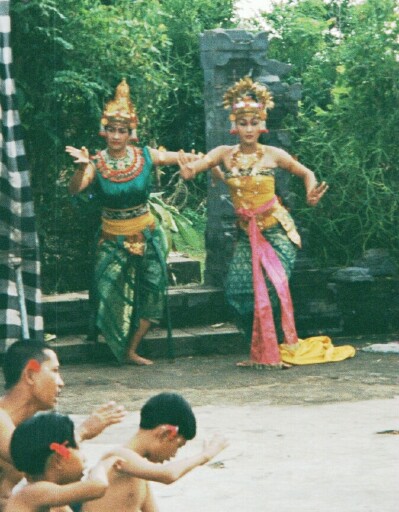 Ramayana
Ramayana. The a cappella chorus of bare-chested men wearing black-and-white checkered sarongs and hibiscus flowers behind their ears chant the distinctive "chak-chak-chak" with intensity, which is distinctive of this dance. These men constitute an army of monkeys. Both men and women participate in this dance, playing, among others, the characters of Prince Rama, his abducted wife Sita, and the evil King Lanka. As in all Balinese performances, in the end, good triumphs over evil.
The
Ramayana story is also performed in several dances of Central Java, the most well known is the
Ramayana Ballet, which is performed in an open-air theater from May through October. The
Wayang Topeng is a dance drama where the characters use masks, dating back to the Majapahit kingdom. The masked characters are identifiable in the same manner as they are in
Wayang Kulit puppet performances. The refined and elongated features denote nobility, whereas the exaggerated and grotesque characteristics indicate the vulgar players.
The Topeng dance of Bali, however, is quite different. The word topeng means "pressed against the face," hence the masks. The Balinese Topeng masks are brightly painted, exaggerated and expressive human faces. The variety of characters indicated by the masks are acted out by a single performer. The stories are often drawn from the chronicles of Balinese history, but comedy, as well as topics dealing with current social issues may be mixed into the performance. The dancer usually chants and speaks only in the Balinese language.
Music
Indonesian gamelan music is the best known Indonesian music. This instrumental ensemble music played on a variety of metal pots, gongs, and drums (the word gamelan refers to the collection of instruments themselves) has enchanted first-time listeners (including Sir Francis Drake who visited Java in 1580) with its blend of exotic modality and shimmering timbre. Said to have been created by a Javanese king in the 3rd century, the gamelan has retained its ceremonial function in the royal courts of Java and Bali, while evolving into a modern folk form.
In recent years there has been a remarkable surge of American and European interest in gamelan music. Buying a ticket to Indonesia to attend a live concert is no longer necessary, as many major universities have their own ensembles. A listing of gamelan music groups in the United States can be found in the Explorers' Room.
Despite its high profile across the world, the gamelan is not representative of all Indonesian music. Among the many different music styles from the various cultures across this maritime continent, two other major music types that have become common are kroncong and dangdut.
he roots of kroncong music date back to the 16th century when sailors brought Portuguese instruments and melodies to Indonesia. The ensemble typically consists of plucked string instruments (kroncong is the name of a ukulele-like instrument), a flute, and a female singer. Over the steadily plucked arpeggios that provide the harmonic backdrop, the singer croons languidly of love, yearning, sadness, and the beauty of the countryside, as the flute flits up and down the scales in free-improvisational flight. Although the instruments and the singing style are clearly descended from European origins, the chord progression provides an unsettling flavor to the songs. The langgam jawa, a regional variation, uses Javanese gamelan scales.
Dangdut is far more popular today, and it can be heard blaring from the loudspeakers of bemos (minivans used for public transport), storefront TV sets tuned to the music video channel, and, at night, from karaoke bars. As in rock music, there is a fairly wide range of music that gets classified as dangdut. The instrumentation and song forms of today's dangdut are obviously influenced by rock music, but it has its roots in orkes melayu, a music style that combined Malay and Western elements, as well as in Indian film music and urban Arab pop.
Arts
The Indonesian arts are clearly reflective of the overlaying of different religious influences, as well as intermingling of many different ethnic cultures from across the archipelago. Animist traditions are evident in the tribal art found in carving, pottery and weaving crafts. Javanese and Balinese art is strongly influenced by their Hindu-Buddhist roots. With the restrictions against human or animal representations, Islam has caused artists to become more stylized in their approach.
Woodcarving is the most widespread medium of artistic expression across the Indonesian islands. There are as many styles as there are cultures. Many carvings are deeply steeped in religious and spiritistic practices, but they can also serves a decorative function. All manner of objects are heavily carved from wood, including temple doors, furniture, totem poles, statutes and masks. With the influx of the tourism industry, artist are rising to the demand and forming new styles purely for ornamental purposes. This has been clearly seen in Bali where years ago woodcarvers began making beautifully smooth, simple, elongated designs with a natural finish.
There is a great variety in the techniques, colors, materials and design of Indonesian
textiles. The three main groups are
ikat, which is made with tie-dyed patterns on threads before they are woven;
songket, which produces a showy fabric using silver and gold threads woven into
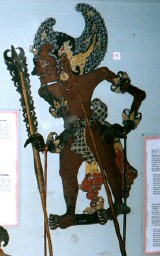
silk; and
batik, which alternates waxed designs with the dyeing process.
Within each of these textile groups there is distinctive regional variety of technique and pattern.
The well-known shadow puppets of Java and Bali, the wayang kulit, are made of leather. They are cut from buffalo hide and carved into lace-like figures using a sharp stylus, and then painted. Other puppet styles include the three-dimensional Sundanese wayang golek made of wood, and the lesser known and seldom seen flat wooden klitik puppets of East Java.
Beautiful
silver jewelry is produced both in Bali and Central Java. The Balinese designs are usually handmade of both traditional designs and those adapted by copying western styles. The Javanese silver designs
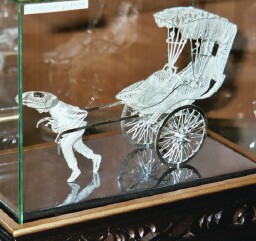
are known for their intricate filigree work both with jewelry and decorative models.
Balinese painting styles flourished after World War I with the influence of western artists Walter Spies and Rudolph Bonnet. Before that time, traditional paintings were used to decorate temple walls and were quite limited in style and theme, usually similar to the wayang kulit two-dimensional view. With the westerners' influence, subject matters embraced single scenes from everyday life and the expanded use of color and varying styles. Painting emerged as a stand-alone art form, and not just a way to decorate temple spaces, which was a new concept to the Balinese at the time.
Religion
When Indonesia proclaimed its independence in 1945, it adopted freedom of religion. However, today it is almost exclusively a Muslim country. Indonesia is, in fact the largest Muslim nation in the world, and the vast majority practice a moderate form of Islam. But there is also a small minority of other religions present.
 | Muslim: 88% |
 | Christian (Protestant and Catholic): 10% |
 | Hindu and Buddhist: 2% | | | | |
About 2,000 years ago, villages in Java developed into small kingdoms made up of several villages with a chief. Each small kingdom developed its own variation of ethnic and tribal religion. These early Indonesians 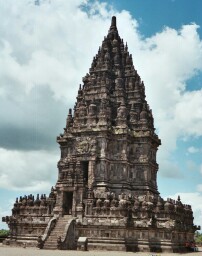 were animists and practiced ancestor worship, as well as spiritism. Over time, social and religious duties were refined into a code of behavior, or adat.
were animists and practiced ancestor worship, as well as spiritism. Over time, social and religious duties were refined into a code of behavior, or adat.
During a period of almost 700 years, these developing kingdoms had close trade ties with India, which eventually fostered the Hindu civilization that took root in Indonesia, overlaying the existing religious animism and adat. It is believed by some historians that Hindu priests from India were invited to advise the new Indonesian kings, providing occult powers and a mythological basis from which to rule. Buddhist influence was also added to the cultural mix by way of Chinese 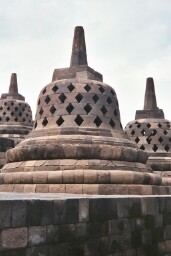 traders who still wielded notable influence.
traders who still wielded notable influence.
Cultural influences from both India and China were mixed in. Significant Buddhist influence can be seen in Javanese architecture of the 8th and 9th centuries, such as is found in the huge monument of the Borobudur temple. Yet the most outstanding example of Hindu art can be found nearby in the largest Hindu temple complex in Java, namely Prambanan.
Marco Polo, who was the first European to visit Indonesia.
Around the year 1290 he stopped at northern Sumatra on his way back from a visit to Kublai Khan's court in China. He noted that even though the people of Sumatra were generally idol worshippers, "many of those who dwell in the seaport towns have been converted to the religion of Mohammed." The spread of Islam came by means of the visiting merchants from the Persian Gulf and India, with some of them settling in the Strait of Malacca, the primary trade channel in Southeast Asia.
The local rulers accepted the teachings of Mohammed and the Qur'an, as did their subjects. Interestingly, there was no clean break with the past, since Muslim mosques were built using Hindu-Javanese architectural style. In fact, throughout Indonesian history, the division between cultures and overlaid religions has never been clear.
It is believed that the first Muslims may have already been in Indonesia as early as the 11th century. By the 15th century, Islam spread from west to east, overtaking many of the Indonesian islands during the century-long decline of the Majapahit kingdom, which was said to be the greatest of all Indonesian Hindu kingdoms, controlling most of the archipelago. Indonesia has remained primarily Muslim to this day, with the exception of the small island of Bali, where the Javanese Hindu prince fled when Islam overtook Java.
Christianity also arrived with the steady march of the Europeans who have had some influence into modern times. During the Suharto take-over in 1965, citizens were forced to claim a religion. If one did not have a religion, they were considered Communist, and Communists were executed. That meant that many Chinese took on Christianity, which only served to fuel the conflict between them and the indigenous Indonesians. Conflicts between Christians and Muslims still flare up in certain parts of Indonesia, but more commonly co-exist side-by-side. The island of Flores is mostly Christian, as well as some enclaves in the Moluccas and on Kalimantan. However, Indonesia remains primarily Muslim and claims its place as the most populous Muslim nation in the world.
People
As a nation of islands large and small over a vast area, Indonesia's citizens are made up of a multitude of separate island peoples resulting in an extremely diverse cultural and linguistic mosaic. A staggering 300 ethnic groups and over 365 languages and dialects are still alive and well among the large population of over 217 million people. It is therefore appropriate that the national motto Bhimeka Tunggal Ika (Unity in Diversity) was adopted by the Indonesian government.
A melting pot of sorts, making it vaguely similar to the United States in this way, the heritage of the Indonesian people is not often easily defined. Many have at least some Malay heritage, originating in China. But Indonesia also includes isolated tribes, some with origins from Sri Lanka, or scattered pockets of indigenous dark-skinned people, such as those of the Dani tribe on the eastern island of Irian Jaya. Because of the influence of traveling Chinese and Arab merchants, as well as the successive invasions by the Portuguese, Spanish, English, and finally the Dutch, who held colonial domination over Indonesia for many years, in reality there are many nations mixed into the modern-day Indonesian bloodline.
The major ethnic groups that can be found on the two most populated islands of Java and Bali are the Javanese, Sundanese, Balinese and Overseas Chinese. The following is a bit of information on each group.
Javanese – This is the largest and most dominant ethnic group in Indonesia. Yogyakarta, located in Central Java, is the center of Javanese culture, as well as an eclectic university town and popular tourist destination. The majority of Javanese people today are Muslim, but their culture owes much to animism as well as Hinduism.
As is true with many of the cultural groups in Indonesia, the Javanese also have their own language. It is quite complex when compared to the more easily learned national language of Bahasa Indonesia (Indonesian). The Javanese language has nine levels ranging from low to high, reflecting status, age and familiarity between speakers. There are regional variations too. The Javanese language of East Java is more course and generally considered less respectful than that spoken in Central Java. In Central Java, politeness and good manners are highly regarded. Loud displays of emotion are considered quite rude. Thus, the Javanese are known for their indirectness and deference to authority in order to avoid negative, embarrassing or uncomfortable feelings. This trait stems from the Hindu court traditions of pre-Islamic influence.
It is not uncommon for Javanese people to use one name, although at times a common family name is chosen in upper class families. The Javanese are also known for world-famous arts, such as batik fabrics, gamelan percussion orchestral music, and the adapted Indian legend-based stories presented in shadow puppet plays known as wayang kulit.
Sundanese – The Sundanese people are primarily found in West Java and are the second largest ethnic group in Indonesia. Though less formal and indirect in their etiquette than the Javanese in the central part of the island, they are quite down to earth in nature. The Sundanese are now primarily Islamic, but much Hindu and animism influences remain. They share many similarities with the Javanese, such as their language. Though distinctly different, it is hierarchical based on age and status, which affects the level of speech.
The Sundanese version of Javanese shadow puppet plays is done with three-dimensional wooden puppets, called wayang golek. While the Javanese are known for their gamelan music (a variety of xylophone-type percussion instruments), the Sundanese are known for their suling or flute music. Spiritism is also interwoven into Sundanese culture, including belief in sorcery and magic.
Balinese – As the name indicates, these are the people of Bali, the famed tourist island paradise. Bali conjures visions of steaming volcanoes, vibrant tropical greenery, breath-taking ocean cliffs and long white and black sand beaches. The Balinese people are no less exotic than their island. Indonesia was predominantly Hindu before the spread of Islam. Bali is the only remaining Hindu island in the nation. To this day, the Balinese people have a strong connection to village life, even those who have moved to the city for employment or to work in the tourist center of Kuta at the South of the island. Village life is highly organized and land ownership and use are of prime concern.
Family status in Bali is reflected in names, which is reminiscent of the old Hindu caste system. Often children are named according to birth order. The main castes in Bali are: Brahman, the priestly class who use the title Ida Bagus (male) or Ida Ayu (female). Next is the Satria, who often use the name Agung Gede in their name and were the former ruling class. Then there is the Wesya, who were former lower nobility and sometimes use the title Gusti. Finally, the most common caste is the Sudra. Usually the first four children are named in the following order if born into this caste: Wayan, Made, Nyoman and Ketut, regardless of gender. The Balinese naming system is complex and not easily understood from a Western standpoint, but hopefully this brief review will give a flavor for some of the more common names in Bali.
The primary religion on Bali is a hybrid form of Hinduism and Buddhism, which borrows much of its intricate ritual and drama from Indian Hinduism, but is also uniquely mixed with animism, where it is believed that the gods dwell in the mountains, particularly Mount Agung, the tallest mountain on Bali. Gunung Agung, as it is called by the Balinese, is really one of several active volcanoes on the island. Bali has been called "The Island of the Gods" and this is not only believed seriously by the Balinese, but many Indonesians across the archipelago believe that this island has special powers and is sacred.
The daily lives of the Balinese revolve around their religion, which includes many festivals tied to the village temples. Each village has three main temples: Origin Temple, Village Temple and Death Temple. Each Balinese family also has a temple in their home. This family temple is to honor ancestors and is used for prayer and small daily offerings. Bali's many festivals also serve as a main cultural attraction for tourists to the island. Almost daily processions in traditional festival attire, with colorful, decorative offerings to the gods en tow, as well as frequent full-costume dance performances and Balinese gamelan music are as exotic as the tropical island setting itself.
Overseas Chinese – The Chinese are the most important ethnic minority in Indonesia. They make up less than 3% of the total population and are primarily found living in the port cities of Java, Sumatra and Kalimantan. No other immigrants have had a greater impact on the Indonesian economy. They have been very successful businesspeople and are by far the most prosperous ethnic group in the country. This fact alone causes much anti-Chinese sentiment from other ethnic groups in Indonesia.
The Dutch also had a hand in the immigration and success of the Chinese, encouraging them as an entrepreneurial middle class. Unfortunately, the Chinese are therefore viewed as an over-privileged group and there has even been legal discrimination against their culture, such as with the banning of Chinese language literature and schooling, as well as making it difficult for Chinese people to become Indonesian citizens.
Despite social prejudices, many Chinese have taken on Indonesian names, speak Indonesian, and are slowly blending into Indonesian society. There are now many generations of Overseas Chinese, as they are called, who view Indonesia as home along with all of the other diverse peoples of Indonesia. In recent years, the Chinese-influenced culture is being accepted more and more, such as the government recognizing and accepting the celebration of the Chinese New Year.





 strange lion-shaggy dog creature that is operated much like the two-man circus horse, is the protector of a village and personifies good. Rangda is the evil widow witch. There are also barong supporters, men flailing dagger-like krises. Although the barong is playful and jovial, once Rangda makes her attacking appearance, he becomes the protector and battles, along with the retaliating kris-armed men. Rangda puts the men in a trance and they turn the daggers on themselves. The barong's magical powers see to it that the men are not harmed in the process. Amid the crashing din of the gamelan accompaniment, good and evil battle. The barong triumphs and Rangda finally retreats in defeat.
strange lion-shaggy dog creature that is operated much like the two-man circus horse, is the protector of a village and personifies good. Rangda is the evil widow witch. There are also barong supporters, men flailing dagger-like krises. Although the barong is playful and jovial, once Rangda makes her attacking appearance, he becomes the protector and battles, along with the retaliating kris-armed men. Rangda puts the men in a trance and they turn the daggers on themselves. The barong's magical powers see to it that the men are not harmed in the process. Amid the crashing din of the gamelan accompaniment, good and evil battle. The barong triumphs and Rangda finally retreats in defeat. Ramayana. The a cappella chorus of bare-chested men wearing black-and-white checkered sarongs and hibiscus flowers behind their ears chant the distinctive "chak-chak-chak" with intensity, which is distinctive of this dance. These men constitute an army of monkeys. Both men and women participate in this dance, playing, among others, the characters of Prince Rama, his abducted wife Sita, and the evil King Lanka. As in all Balinese performances, in the end, good triumphs over evil.
Ramayana. The a cappella chorus of bare-chested men wearing black-and-white checkered sarongs and hibiscus flowers behind their ears chant the distinctive "chak-chak-chak" with intensity, which is distinctive of this dance. These men constitute an army of monkeys. Both men and women participate in this dance, playing, among others, the characters of Prince Rama, his abducted wife Sita, and the evil King Lanka. As in all Balinese performances, in the end, good triumphs over evil. silk; and batik, which alternates waxed designs with the dyeing process.
silk; and batik, which alternates waxed designs with the dyeing process.  are known for their intricate filigree work both with jewelry and decorative models.
are known for their intricate filigree work both with jewelry and decorative models. were animists and practiced ancestor worship, as well as spiritism. Over time, social and religious duties were refined into a code of behavior, or adat.
were animists and practiced ancestor worship, as well as spiritism. Over time, social and religious duties were refined into a code of behavior, or adat. traders who still wielded notable influence.
traders who still wielded notable influence.

